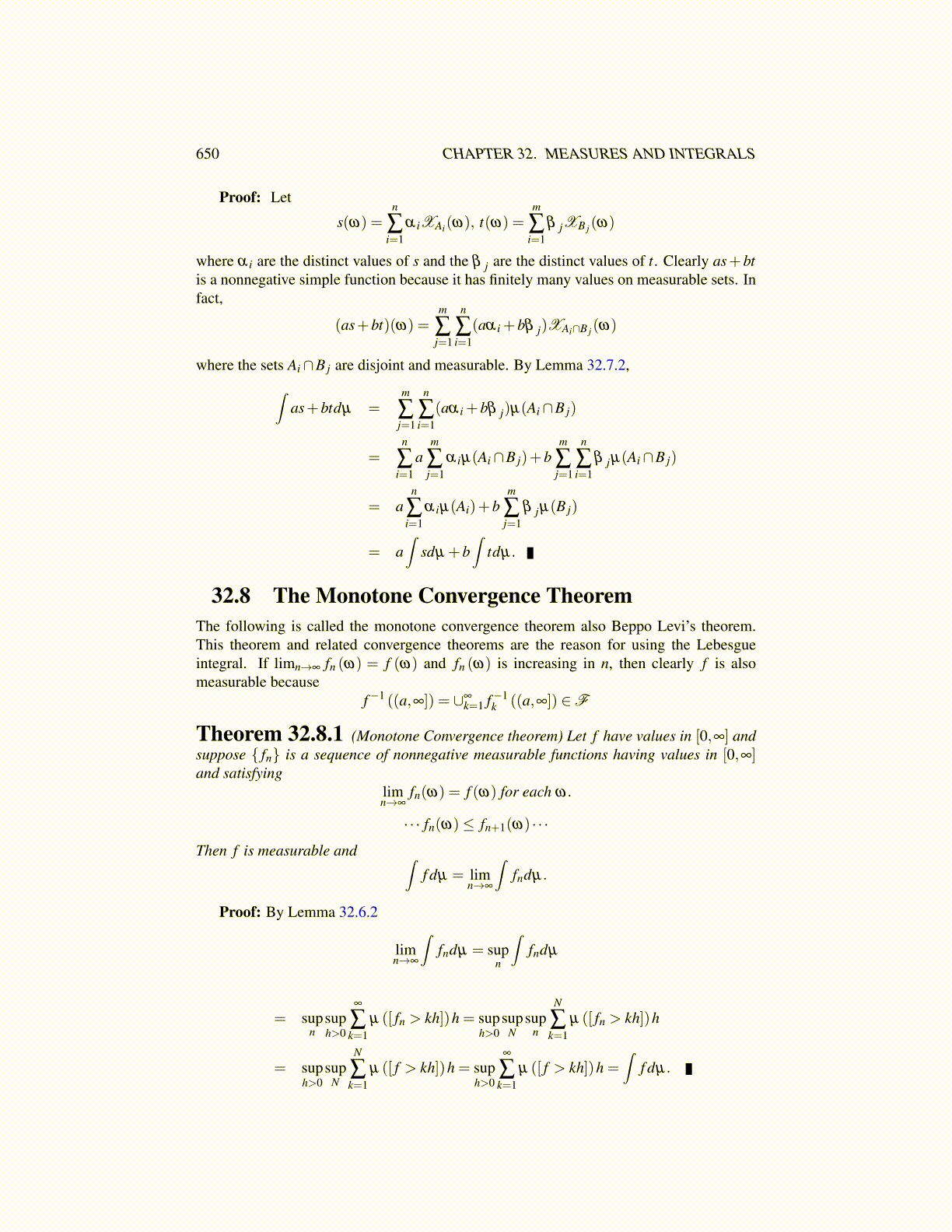
650 CHAPTER 32. MEASURES AND INTEGRALS
Example 32.10.6 Let Ω ≡N and let F be the set of all subsets of Ω. Let µ (E)≡ numberof entries in E. Then (N,F ,µ) is a measure space and the Lebesgue integral is summation.Thus all the convergence theorems mentioned above apply to sums.
First, why is µ a measure? If {Ei} are disjoint, then if each is nonempty, ∪iEi is infiniteand so
µ (∪iEi) = ∞ =∞
∑i=1
µ (Ei)≥∞
∑i=1
1 = ∞
The alternative is that only finitely many Ei are nonempty and in this case, the assertionthat µ (∪iEi) = ∑
∞i=1 µ (Ei) is obvious. Hence µ is indeed a measure. Now let f : N→ R.
It is obviously measurable because the inverse image of anything is a subset of N. So iff (n)≥ 0 for all n, what is
∫f dµ?
f (i) =∞
∑k=1
f (k)X{k} (i) = limn→∞
n
∑k=1
f (k)X{k} (i)≡ fn (i)
Now fn is a simple function and there is exactly one thing in {k}. Therefore,∫
fndµ =
∑nk=1 f (k) . Then, by the monotone convergence theorem,∫
f dµ = limn→∞
∫fndµ = lim
n→∞
n
∑k=1
f (k)≡∞
∑k=1
f (k)
When ∑k | f (k)|< ∞, one has∫
f dµ = ∑∞k=1 f (k) .
This example illustrates how the Lebesgue integral pertains to absolute summabilityand absolute integrability. It is not a theory which can include conditional convergence.The generalized Riemann integral, which I won’t consider here can do this. However, theLebesgue integral is very easy to use because of this restriction.
32.11 Dynkin’s LemmaDynkin’s lemma is a very useful result. It is used quite a bit in books on probability buthere it is used to obtain n dimensional Lebesgue measure without any ugly technicalities.
Lemma 32.11.1 Let C be a set whose elements are σ algebras each containing somesubset K of the set of all subsets. Then ∩C is a σ algebra which contains K .
Proof: /0,Ω are in ∩C because these are each in each σ algebra of C . If Ei ∈ ∩C , thenif F ∈ C it follows that ∪∞
i=1Ei ∈ F and so, since F is arbitrary, this shows this union isin ∩C . If E ∈ ∩C , then EC ∈ F for each F ∈ ∩C and so, as before, EC ∈ ∩C . Thus ∩Cis a σ algebra.
Definition 32.11.2 Let Ω be a set and let K be a collection of subsets of Ω. ThenK is called a π system if /0,Ω ∈K and whenever A,B ∈K , it follows A∩B ∈K . σ (K )will denote the intersection of all σ algebras containing K . The set of all subsets of Ω
is one such σ algebra which contains K . Thus σ (K ) is the smallest σ algebra whichcontains K .
The following is the fundamental lemma which shows these π systems are useful. Thisis due to Dynkin.